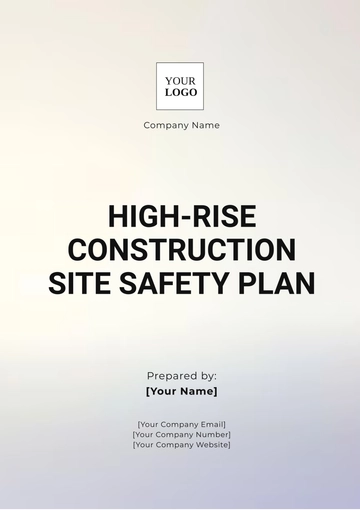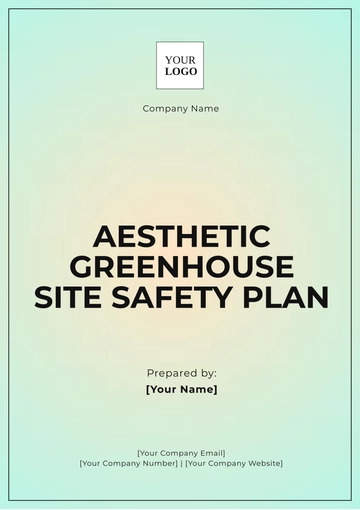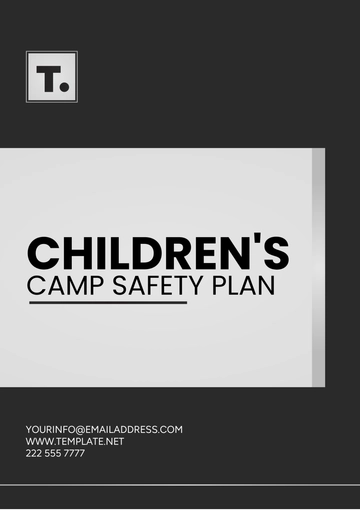Free Steel Manufacturing Site Safety Plan

Prepared By: [Your Name]
Company: [Your Company Name]
1. Introduction
The safety of employees and visitors in a steel manufacturing facility is paramount. This Safety Plan outlines the protocols and procedures designed to ensure a safe working environment, mitigate risks associated with steel manufacturing processes, and comply with relevant safety regulations. This document serves as a guide for all personnel to understand their responsibilities in maintaining safety standards.
2. Objectives
Ensure the safety of all employees and visitors.
Minimize the risk of accidents and injuries.
Comply with all relevant safety regulations and standards.
Promote a culture of safety and awareness among all personnel.
3. Scope
This Safety Plan applies to all employees, contractors, and visitors at the steel manufacturing site. It encompasses all areas of the facility, including production, maintenance, storage, and administrative offices.
4. Roles and Responsibilities
Role | Responsibilities |
|---|---|
Management | Management is responsible for ensuring compliance with safety regulations, providing necessary resources for safety training and equipment, and conducting regular safety audits and inspections. |
Supervisors | Supervisors monitor daily operations for safety compliance, provide training to employees on safety protocols, and report and investigate any safety incidents or near misses. |
Employees | Employees are required to follow all safety procedures and protocols, participate in safety training and drills, and report any hazards or unsafe conditions to supervisors immediately. |
5. Safety Procedures
5.1 General Safety Rules
Personal Protective Equipment (PPE): All employees must wear appropriate PPE, including helmets, gloves, safety glasses, and steel-toed boots, as required for their specific tasks.
Housekeeping: Maintain a clean and organized work area. Spills must be cleaned immediately to prevent slips and falls.
Emergency Exits: All exits must remain clear and accessible at all times. Employees should be familiar with the location of emergency exits and evacuation routes.
Reporting Hazards: Employees must report any safety hazards or incidents to their supervisor without delay.
5.2 Equipment Safety
Machine Safety: All machines must have proper guards and safety devices in place. Employees must be trained in the safe operation of machinery.
Lockout/Tagout (LOTO): Implement LOTO procedures to ensure that equipment is properly shut off and not able to be started up again until maintenance or servicing is completed.
Forklift and Crane Operations: Only trained and certified personnel may operate forklifts and cranes. Daily inspections must be conducted before use.
5.3 Fire Safety
Fire Extinguishers: Fire extinguishers must be accessible and regularly inspected. Employees should be trained in their use.
Emergency Evacuation Plan: An emergency evacuation plan must be in place, including designated assembly points. Regular drills should be conducted to ensure all personnel are familiar with the procedures.
5.4 Chemical Safety
Material Safety Data Sheets (MSDS): Employees must be familiar with MSDS for all chemicals used on-site. Proper storage and labeling of chemicals are mandatory.
Spill Response: Procedures for responding to chemical spills must be established, and employees should be trained on these procedures.
6. Training and Communication
Safety Training: All employees must receive safety training upon hiring and participate in ongoing training sessions. Training topics should include general safety practices, equipment operation, emergency response, and chemical safety.
Safety Meetings: Regular safety meetings should be held to discuss safety issues, share best practices, and review incidents.
7. Incident Reporting and Investigation
Reporting: All incidents, including near misses, must be reported immediately. An incident report form should be completed by the involved employee and their supervisor.
Investigation: A thorough investigation of all incidents will be conducted to determine root causes and prevent recurrence. Findings will be documented, and corrective actions will be implemented.
8. Emergency Response Plan
Emergency Contacts: A list of emergency contacts, including local emergency services, must be posted throughout the facility.
First Aid: First aid kits must be available and accessible in designated areas. Employees trained in first aid should be identified and readily available.
Emergency Drills: Regular emergency drills should be conducted to ensure preparedness for various emergencies, including fire, chemical spills, and severe weather.
9. Review and Continuous Improvement
This Safety Plan will be reviewed annually or whenever significant changes occur in operations or regulations. Continuous improvement efforts will be made by soliciting feedback from employees and monitoring safety performance metrics.
10. Conclusion
A safe working environment in a steel manufacturing facility is essential for the well-being of employees and the successful operation of the site. By following this Safety Plan, all personnel can contribute to a culture of safety that minimizes risks and protects everyone involved in the manufacturing process.
- 100% Customizable, free editor
- Access 1 Million+ Templates, photo’s & graphics
- Download or share as a template
- Click and replace photos, graphics, text, backgrounds
- Resize, crop, AI write & more
- Access advanced editor
Enhance workplace safety in your steel manufacturing facility with the Steel Manufacturing Site Safety Plan Template from Template.net. This editable and customizable template is designed to meet the specific safety needs of the steel industry. Easily modify its content to align with your site's protocols and regulatory standards. With a clear structure and detailed guidelines, you can effectively implement essential safety measures, ensuring the protection of your workforce and equipment.
You may also like
- Finance Plan
- Construction Plan
- Sales Plan
- Development Plan
- Career Plan
- Budget Plan
- HR Plan
- Education Plan
- Transition Plan
- Work Plan
- Training Plan
- Communication Plan
- Operation Plan
- Health And Safety Plan
- Strategy Plan
- Professional Development Plan
- Advertising Plan
- Risk Management Plan
- Restaurant Plan
- School Plan
- Nursing Home Patient Care Plan
- Nursing Care Plan
- Plan Event
- Startup Plan
- Social Media Plan
- Staffing Plan
- Annual Plan
- Content Plan
- Payment Plan
- Implementation Plan
- Hotel Plan
- Workout Plan
- Accounting Plan
- Campaign Plan
- Essay Plan
- 30 60 90 Day Plan
- Research Plan
- Recruitment Plan
- 90 Day Plan
- Quarterly Plan
- Emergency Plan
- 5 Year Plan
- Gym Plan
- Personal Plan
- IT and Software Plan
- Treatment Plan
- Real Estate Plan
- Law Firm Plan
- Healthcare Plan
- Improvement Plan
- Media Plan
- 5 Year Business Plan
- Learning Plan
- Marketing Campaign Plan
- Travel Agency Plan
- Cleaning Services Plan
- Interior Design Plan
- Performance Plan
- PR Plan
- Birth Plan
- Life Plan
- SEO Plan
- Disaster Recovery Plan
- Continuity Plan
- Launch Plan
- Legal Plan
- Behavior Plan
- Performance Improvement Plan
- Salon Plan
- Security Plan
- Security Management Plan
- Employee Development Plan
- Quality Plan
- Service Improvement Plan
- Growth Plan
- Incident Response Plan
- Basketball Plan
- Emergency Action Plan
- Product Launch Plan
- Spa Plan
- Employee Training Plan
- Data Analysis Plan
- Employee Action Plan
- Territory Plan
- Audit Plan
- Classroom Plan
- Activity Plan
- Parenting Plan
- Care Plan
- Project Execution Plan
- Exercise Plan
- Internship Plan
- Software Development Plan
- Continuous Improvement Plan
- Leave Plan
- 90 Day Sales Plan
- Advertising Agency Plan
- Employee Transition Plan
- Smart Action Plan
- Workplace Safety Plan
- Behavior Change Plan
- Contingency Plan
- Continuity of Operations Plan
- Health Plan
- Quality Control Plan
- Self Plan
- Sports Development Plan
- Change Management Plan
- Ecommerce Plan
- Personal Financial Plan
- Process Improvement Plan
- 30-60-90 Day Sales Plan
- Crisis Management Plan
- Engagement Plan
- Execution Plan
- Pandemic Plan
- Quality Assurance Plan
- Service Continuity Plan
- Agile Project Plan
- Fundraising Plan
- Job Transition Plan
- Asset Maintenance Plan
- Maintenance Plan
- Software Test Plan
- Staff Training and Development Plan
- 3 Year Plan
- Brand Activation Plan
- Release Plan
- Resource Plan
- Risk Mitigation Plan
- Teacher Plan
- 30 60 90 Day Plan for New Manager
- Food Safety Plan
- Food Truck Plan
- Hiring Plan
- Quality Management Plan
- Wellness Plan
- Behavior Intervention Plan
- Bonus Plan
- Investment Plan
- Maternity Leave Plan
- Pandemic Response Plan
- Succession Planning
- Coaching Plan
- Configuration Management Plan
- Remote Work Plan
- Self Care Plan
- Teaching Plan
- 100-Day Plan
- HACCP Plan
- Student Plan
- Sustainability Plan
- 30 60 90 Day Plan for Interview
- Access Plan
- Site Specific Safety Plan





























